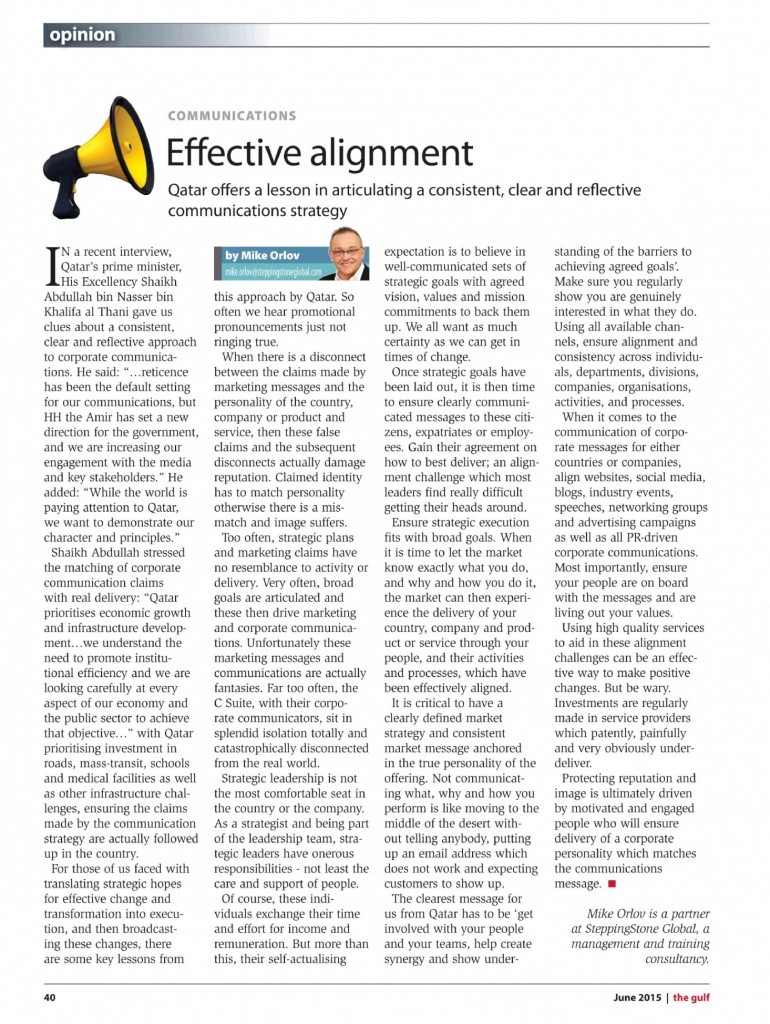Qatar offers a lesson in articulating a consistent, clear and reflective communications strategy
In a recent interview, Qatar’s prime minister, His Excellency Shaikh Abdullah bin Nasser bin Khalifa al Thani gave us clues about a consistent, clear and reflective approach to corporate communications. He said: “…reticence has been the default setting for our communications, but HH the Amir has set a new direction for the government, and we are increasing our engagement with the media and key stakeholders.” He added: “While the world is paying attention to Qatar, we want to demonstrate our character and principles.”
Shaikh Abdullah stressed the matching of corporate communication claims with real delivery: “Qatar prioritises economic growth and infrastructure development…we understand the need to promote institutional efficiency and we are looking carefully at every aspect of our economy and the public sector to achieve that objective…” with Qatar prioritising investment in roads, mass-transit, schools and medical facilities as well as other infrastructure challenges, ensuring the claims made by the communication strategy are actually followed up in the country.
For those of us faced with translating strategic hopes for effective change and transformation into execution, and then broadcasting these changes, there are some key lessons from this approach by Qatar. So often we hear promotional pronouncements just not ringing true.
When there is a disconnect between the claims made by marketing messages and the personality of the country, company or product and service, then these false claims and the subsequent disconnects actually damage reputation. Claimed identity has to match personality otherwise there is a mis-match and image suffers.
Too often, strategic plans and marketing claims have no resemblance to activity or delivery. Very often, broad goals are articulated and these then drive marketing and corporate communications. Unfortunately these marketing messages and communications are actually fantasies. Far too often, the C Suite, with their corporate communicators, sit in splendid isolation totally and catastrophically disconnected from the real world.
Strategic leadership is not the most comfortable seat in the country or the company. As a strategist and being part of the leadership team, strategic leaders have onerous responsibilities – not least the care and support of people.
Of course, these individuals exchange their time and effort for income and remuneration. But more than this, their self-actualising expectation is to believe in well-communicated sets of strategic goals with agreed vision, values and mission commitments to back them up. We all want as much certainty as we can get in times of change.
Once strategic goals have been laid out, it is then time to ensure clearly communicated messages to these citizens, expatriates or employees. Gain their agreement on how to best deliver; an alignment challenge which most leaders find really difficult getting their heads around.
Ensure strategic execution fits with broad goals. When it is time to let the market know exactly what you do, and why and how you do it, the market can then experience the delivery of your country, company and product or service through your people, and their activities and processes, which have been effectively aligned.
It is critical to have a clearly defined market strategy and consistent market message anchored in the true personality of the offering. Not communicating what, why and how you perform is like moving to the middle of the desert without telling anybody, putting up an email address which does not work and expecting customers to show up.
The clearest message for us from Qatar has to be ‘get involved with your people and your teams, help create synergy and show understanding of the barriers to achieving agreed goals’. Make sure you regularly show you are genuinely interested in what they do. Using all available channels, ensure alignment and consistency across individuals, departments, divisions, companies, organisations, activities, and processes.
When it comes to the communication of corporate messages for either countries or companies, align websites, social media, blogs, industry events, speeches, networking groups and advertising campaigns as well as all PR-driven corporate communications. Most importantly, ensure your people are on board with the messages and are living out your values.
Using high quality services to aid in these alignment challenges can be an effective way to make positive changes. But be wary. Investments are regularly made in service providers which patently, painfully and very obviously under-deliver.
Protecting reputation and image is ultimately driven by motivated and engaged people who will ensure delivery of a corporate personality which matches the communications message.

